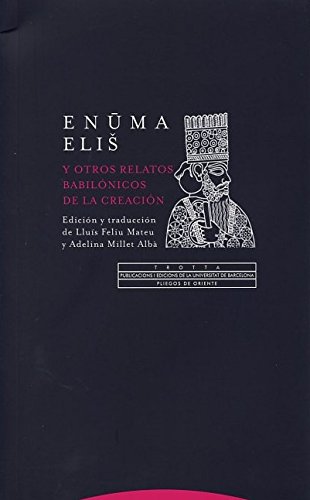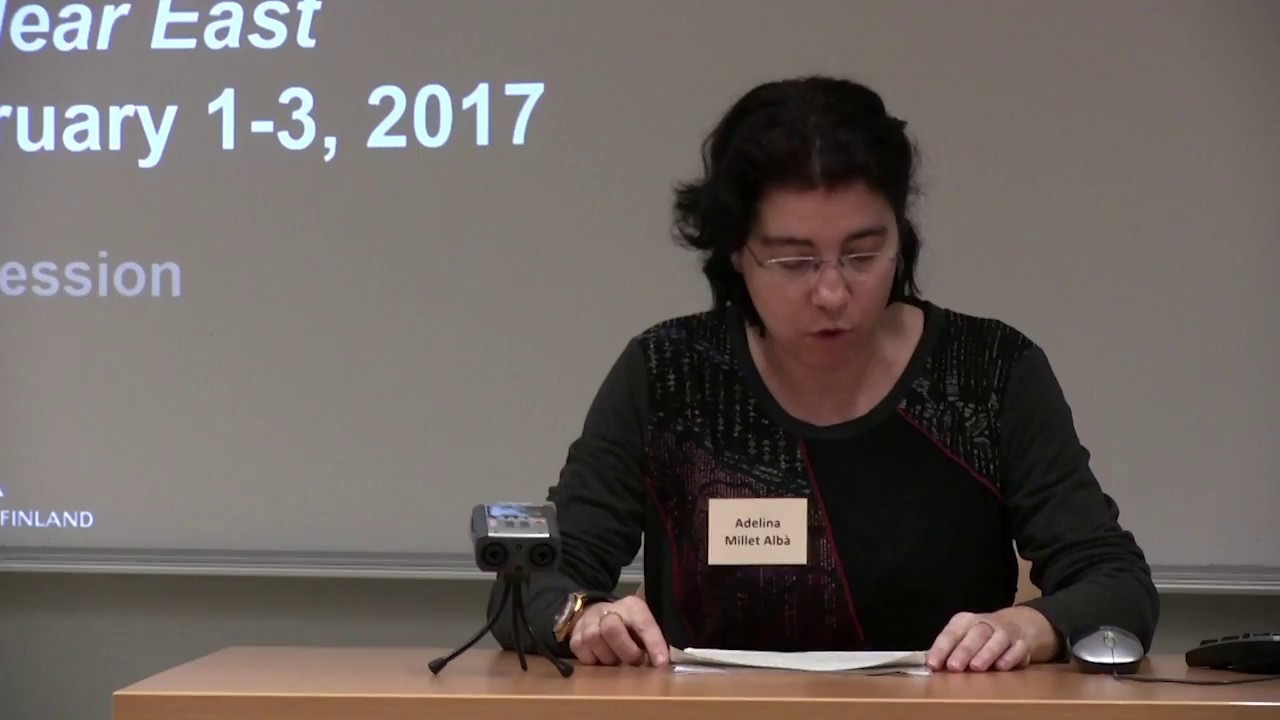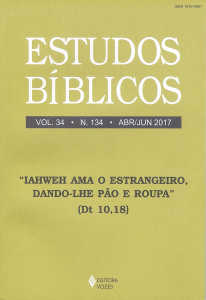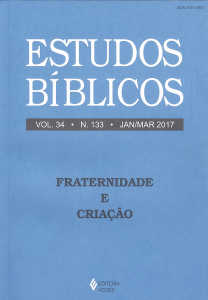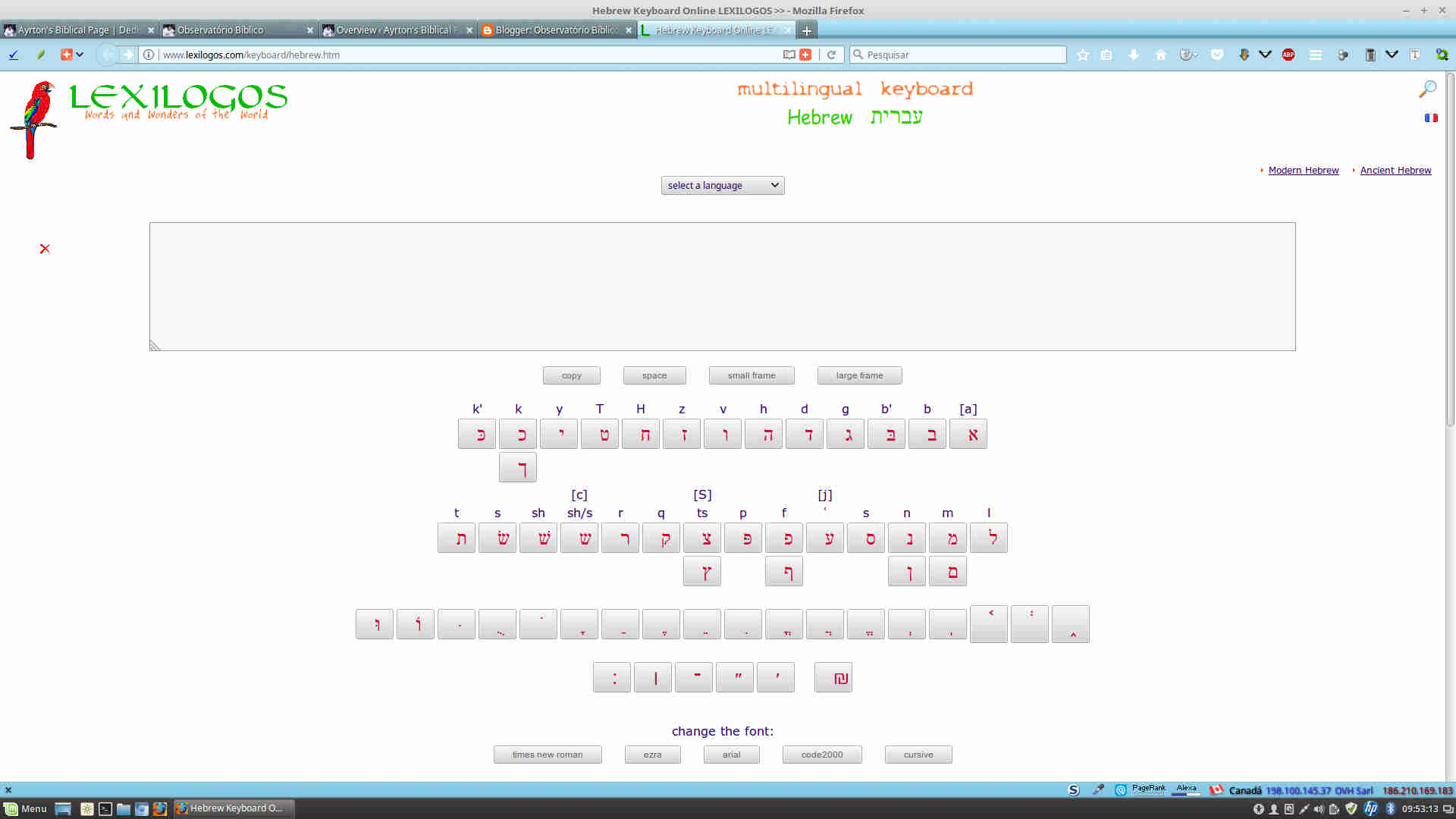Notas aleatórias de leitura do clássico de W. G. Lambert. Para quem quer saber mais sobre o Enuma Elish esta obra é muito boa.
LAMBERT, W. G. Babylonian Creation Myths. Winona Lake, Indiana: Eisenbrauns, 2013, XVI + 640 p. – ISBN 9781575062471.
p. 9
Data de composição do Enuma Elish
Cerca de 1100 a.C. Mas, sobre isso não há acordo. Estudiosos competentes já opinaram por datas que vão de 1700 a 750 a.C.
Even if there was so precise a date of composition, there is as yet no agreement when it was. Competent scholars have expressed opinions ranging from 1700 to 750 b . c . Even if our date of c. 1100 b . c . is accepted, it is not a very helpful conclusion in this connection, since we have no contemporary copies of original compositions from this period to show what our Epic might have looked like, orthographically and grammatically, when new.
p. 34
Poesia?
Só podemos dizer que o Enuma Elish está escrito em uma forma métrica relativamente regular.
In conclusion we can only say that the Epic is written in a relatively strict metrical form, and sofar as present knowledge goes, there is no lack of parallels in either the second or the first millennium.
p. 147
O climax: os 50 nomes de Marduk
Embora o leitor ocidental moderno possa pensar que o clímax do Enuma Elish consiste na vitória de Marduk sobre Tiamat e na criação do homem, é provável que o autor babilônico tenha considerado como clímax do texto os 50 nomes de Marduk. Pelo menos ele dedicou mais espaço a este item do que a qualquer outro na epopeia.
Although to a modern Western reader, the climax of the Epic might seem to consist of Marduk’s victory over Tiāmat and the creation of man, one may suspect that the Babylonian author considered the giving of Marduk’s fifty names as the true climax. At least more space is devoted to this than to any other single item in the Epic. The listing of a deity’s names is known in other literary works.
p. 160-161
Obviamente nenhum deus precisava de 50 nomes para ser identificado. O que conta são os significados teológicos dos nomes.
No god of course needed 50 names for purposes of identification. It was the meanings of the names which accounts for the interest in collecting and handing down so many. The names became loaded with theological meaning, which could be read straight out of many of the secondary titles, but which often had to be read into the older names.
p. 169
Sobre a organização do Universo
Além do Enuma Elish, não há outra abordagem sistemática da cosmologia na literatura acádica. O texto mais longo que lida com este aspecto é a Epopeia de Atrahasis, mas ela é muito mais uma história babilônica da humanidade do que uma cosmologia. Mas isto não significa que o Enuma Elish contém tudo o que é conhecido da cosmologia babilônica. Pelo contrário, o Enuma Elish faz apenas uma seleção de material já disponível. A ideia de que originalmente céu e terra eram unidos é muito difundida na mitologia mundo afora.
Other than Enūma Eliš, there is no systematic treatment of cosmology in Sumero-Babylonian literature. The longest literary text dealing with any aspect of this topic is the Atra-ḫasis Epic, but this has rightly been called “a Babylonian history of mankind,” for it begins with the universe in essentially its present form and takes up the circumstances which led to the creation of man, with subsequent history up to the flood. But this does not mean that Enūma Eliš presents all that is known of Babylonian cosmology. On the contrary, the Epic uses only a selection of the wealth of available material, as will be seen in the case of the theogony (see pp. 405–426). Here, too, parallels to Marduk’s work have to be collected from allusions and incidental comments.
The idea that originally heaven and earth had been joined, or were closely connected, is very widespread in world mythology. This is not the place to pursue every attestation of the idea, and attention will be restricted to those expressions of the idea which could have been a factor in the intellectual background of the author of the Epic.
p. 172
Quando trata da organização dos céus, o autor do Enuma Elish está mais preocupado em fixar o calendário do que expor princípios astronômicos: com as estrelas ele regulamenta o ano; com a lua, o mês; com o sol, o dia.
The ordering of the heavens in Enūma Eliš proceeds on what might at first sight seem astronomical principles. More careful study shows that the real interest of the author lay in fixing the calendar rather than in astronomy per se. The stars with which he deals fix the year, then he passes to the moon, by which the month is fixed, and he concludes this part of his work by treating the sun, the regulator of the day. This orderly treatment and the neglect of anything else astronomical shows where his real interests lay. A contrast is offered by the account of Berossus, according to which Bēl stationed the stars, sun, moon, and the five planets. The planets offer no guide to fixing the calendar.
p. 192
A seção que trata da organização da terra é bem mais curta do que a parte que trata dos céus.
The section dealing with Marduk’s arrangement of the lower part of Tiāmat’s body is both briefer than that about heaven, and fewer parallels can be adduced. This is a not unexpected phenomenon, as the organization of heaven was a traditional topic of mythology, as demonstrated, though none of the examples has any connection with Tiāmat’s body. Thus, in Enūma Eliš the only part of the body named in connection with the heavens is Tiāmat’s belly (kabattu: V 11), where Marduk located the height of heaven. The organization of earth was much more an invention of the author of the Epic, and here all the parts of Tiāmat’s body turn up: head, eyes, nostrils, udder, and tail. Sofar as the present writer has been able tofind, only the eyes are mentioned elsewhere.
p. 202
Os conflitos
Dois conflitos são contados no Enuma Elish: o primeiro, entre Ea e Apsu; o segundo, entre Marduk e Tiamat.
Two conflicts are recounted in Enūma Eliš. The first, in Tablet I, is between Ea and Apsû; the second, in Tablet IV, is between Marduk and Tiāmat. Their backgrounds are immensely complicated. The related material is of two types: (1) written myths and allusions, and (2) iconographic material. The latter consists of both surviving representations and textual references to images and similar things which have since disappeared. Visual representations of mythical creatures and scenes need not have been entirely secondary to myths in narrative form. A relief, for example, could have influenced the compiler of a mythological narrative, though evidence is not likely ever to survive. The general picture of conflict myths in ancient Mesopotamia is of a mass of data. Different traditions and varying forms of the same tradition are constantly merging and separating. At one moment, a group of unrelated items coalesce into a concrete scheme, then an individual item has attention and the others are forgotten. Some will appear in other groupings and may in the process change their identity while keeping their names. The basic mythological themes will appear at different times and places in a quite different garb. The dangers of such study are very obvious. One may insist on a rigorous fragmentation except where specific evidence compels the acknowledgement of a connection, or one may operate with such vague “themes” that everything becomes a manifestation of them. The treatment of the topic here will be to present first the evidence for three groups of mythological conflicts: Ninurta’s victories, conflicts in expository texts and groups of defeated gods. The first are acts of valour alone, while the second and third are concerned with succession: battles among gods resulting in new dynasts. After this background material has been presented, the individual powers and groups who participate in the conflicts in Enūma Eliš will be dealt with in turn.
p. 217
Apsû
Apsu aparece em muitos lugares como o nome das águas primordiais sob a terra, de onde brotam as nascentes. Como nome de uma divindade viva, uma personificação das águas, ele é muito mais raro. No Enuma Elish Tiamat e Apsu começam como um casal primordial, mas, ainda no começo, Apsu, o princípio masculino, é morto por Ea e se torna um elemento impessoal.
“Apsû” occurs everywhere as the name of the cosmic water beneath the earth on which springs draw, the abode of Ea. It is also the name of a cultic installation in temples. As the name of a living deity, a personification of these waters, it is much less well known. Enūma Eliš begins with Tiāmat and Apsû as the prime pair, but very early in the story Apsû, the male, was killed by Ea and thereupon became an impersonal element in which Ea took up residence. In third-millennium Sumerian documents, a personal Apsû is attested.
p. 236
Tiamat
No Enuma Elish Tiamat é o oceano primordial, o monstro dos monstros, e aquele cujo corpo é dividido para formar os céus e a terra. A concepção do autor varia de vez em quando: numa hora, ela é um corpo aquoso, noutra hora um monstro com corpo e membros de um animal. Apesar de sua importância no Enuma Elish, Tiamat é extremamente esquiva em outras passagens da literatura cuneiforme.
In the Epic, Tiāmat is prominent as the primaeval sea, the monster of monsters, and the one whose body was split to form heaven and earth. The author’s concept of her varies from time to time. Now she is a body of water, now a corporeal monster with animal limbs. Despite her importance in the Epic, she is extremely elusive elsewhere in cuneiform literature. The reason is not far to seek. The cosmographic great sea beneath the earth is replaced in most Sumero-Akkadian thought by the Apsû, the body of water over which Ea presided.
p 248
A ascensão de Marduk no panteão sumero-babilônico
Já que o propósito do Enuma Elish é mostrar como Marduk substituiu Enlil como chefe do panteão sumero-babilônico, um estudo sobre a ascensão de Marduk no seu contexto histórico é relevante, indispensável mesmo, para uma compreensão das razões de nosso texto. Os fatos básicos são: no período sumério, sua cidade, Babilônia, e seu culto tinham pouca importância, mas na época do império babilônico Marduk tornou-se o chefe do panteão e seu culto era o mais importante. O difícil é determinar em que época do império babilônico Marduk tornou-se o deus supremo do panteão. A data geralmente aceita até anos atrás de que o Enuma Elish pertence ao período mais antigo da Babilônia, época de Hamurabi (1792-1750), está sendo revista ultimamente. Muitos especialistas preferem hoje falar da época de Nabucodonosor I: 1125-1104 a.C.
Since the purpose of the Epic was to show that Marduk had replaced Enlil as head of the pantheon, a study of the rise of Marduk in its historical framework is clearly relevant, not to say indispensable, for an understanding of the milieu from which our text springs. Fortunately, there is no dispute about the basic facts: that the god, his city Babylon, and its cult were utterly unimportant in Sumerian times, but under the Late Babylonian empire Marduk was head of the pantheon and his cult was, if not unchallenged, at least de facto supreme. The outstanding problem is to know when this elevation of Marduk took place. If this question can be answered, it will provide us with a terminus a quo for the Epic’s date of composition. It is hardly likely that the author was centuries ahead of his time in holding ideas which were otherwise not in general currency. But the period of Marduk’s elevation will not supply a terminus ante quem. It is hardly possible to judge from the text of the Epic whether it was composed as part of the movement which instated Marduk above the other gods or whether it was a literary expression of views which had been current for centuries.
The procedure of this investigation will be to examine the abundant dated, or datable, documents which give some description of Marduk and to note especially the phrases which bear on his relationship to the other gods. Investigations along these lines have been undertaken before and will be summarized here to save repetition of the material covered. A general opinion which once prevailed was that Marduk became head of the pantheon when Babylon under Hammurabi became the political capital of southern Mesopotamia. It had seemed a logical development that the god of the ruling city should lord it over the other deities. The opening sentence of the prologue to Hammurabi’s laws was commonly cited as proof of this. We shall examine the precise content of the wording in due course. There had in fact been two opponents of the view that Marduk’s rise dates from Hammurabi’s time.
p. 439-440
George Smith em 1876 colocou a data da composição do Enuma Elish “provavelmente em torno de 2000 a.C.” Dois autores discordaram: Aage Schmidt e A. Schott. Já em 1911 Aage Schmidt afirmava: a posição de Marduk como chefe dos deuses, assumindo o lugar de Enlil como chefe do panteão, aconteceu por volta de 1200 a.C. e, portanto, o Enuma Elish, na forma como o conhecemos, não pode ser anterior a esta época. No Código de Hamurabi, por exemplo, Marduk aparece como subordinado aos deuses Anu e Enlil. Mas como Schmidt estava claramente à frente de sua época, sua opinião acabou ignorada pelos estudiosos da área.
George Smith in 1876 put the date of composition as “probably near b . c . 2000,” which was no doubt a round figure based on an informed guess. When, by a . d . 1900, knowledge of Babylonian history had increased and chronologies were being worked out, it appeared that the First Dynasty of Babylon was ruling at about 2000 b . c . and that the great Hammurabi, through whom it achieved political supremacy, had reigned during the preceding century. Thus, on the assumption that the Epic reflected the recent rise of Babylon and its god, George Smith’s date seemed to be vindicated, though he had put Hammurabi c. 1550, and for the first half of the 20th century, the Old Babylonian dating was an orthodox opinion, asserted in varying degrees of probability or certainty, very rarely declared unproven, and only twice controverted. The two dissenters were Aage Schmidt and A. Schott. Schmidt, in his Thoughts on the Development of Religion on the Basis of Babylonian Sources, published in 1911, used the unimpeachable historical method and, observing that Marduk was in the older texts an unimportant god and that even in the Code of Hammurabi he was still subordinate to Anu and Enlil, he concluded that Marduk’s usurpation of Enlil’s place in the pantheon must have occurred about 1200 b . c . and that Enūma Eliš in the form known to us cannot be earlier.
p. 442-443
O Enuma Elish foi escrito na época de Nabucodonosor I. Mas com que finalidade? Foi para incentivar um movimento que queria colocar Marduk como chefe do panteão? Ou foi escrito para celebrar a ascensão de Marduk recentemente conseguida? Ou, ainda, para justificar uma doutrina há muito tempo estabelecida?
Marduk’s position as king of the gods is first asserted officially in the time of Nebuchadnezzar I, and thereafter it becomes the standard doctrine, whereas previously, with equal consistency, Anu and Enlil or Enlil alone had headed the pantheon. In sources lacking official character, there is a single earlier attestation of Marduk’s supremacy, a personal name from the reign of Kudur-Enlil (c. 1250 b . c .), “Marduk-is-king-of-the-gods.” This type of name was common in the Old Babylonian period, during which it occurs with seven other deities but never yet with Marduk. This evidence suggests that the idea arose during the latter part of the Cassite rule and was officially adopted under Nebuchadnezzar I. There is circumstantial evidence which supports this conclusion. With Enūma Eliš, the question is whether it was ahead of, abreast of, or behind the times. Was it written to support and further a movement to secure recognition of Marduk’s kingship over the gods, was it a flourish of trumpets to celebrate a victory just won, or was it a theoretical justification of a long-established doctrine? No doubt, some measure of personal feeling enters into a consideration of these questions, but the present writer rules out of court any suggestion that the author was a visionary with ideas centuries ahead of his time. The blasé manner in which he twists older myths and ideas to his own use and the self-assurance displayed throughout oppose any suggestion that this was all a wild dream or pious hope. If Marduk had not yet been crowned king of the gods, the coronation must have been in view. Thus it seems to us that the reign of Nebuchadnezzar I is the earliest possible date.
p. 458-459
Outro aspecto que deve ser considerado é a proposta que Marduk faz, e os deuses concretizam, para a construção da cidade de Babilônia como o centro do Universo, onde ele reside como rei em seu santuário e onde os deuses se reunem em assembleia. Na época suméria os deuses se reuniam em Nippur. No período babilônico recente eles se reunem em Babilônia onde se celebra o Festival do Ano Novo, o Akitu. Nesta festa o Enuma Elish era lido diante da estátua de Marduk por um sacerdote no quarto dia de Nisan. O Enuma Elish servia para mostrar ao povo a grandeza de Marduk.
Another aspect of the author’s motive has so far not received the attention it deserves. It is his doctrine of the city Babylon. In Tablet V 119–30, Marduk proposes to his fathers the building of Babylon as the central point in the universe, in which he will reside as king, and where the gods from heaven above and Apsû beneath may stay when they convene for an asssembly. The gods give their assent. After man’s creation, the gods in gratitude offer to build a shrine devoted to these purposes (VI 49–54). This is done; the gods build Esagil, Marduk’s temple in Babylon and, seated therein for their first assembly, they give Marduk his fifty names. The interval between the proposal and its achievement only emphasises the point, since the matter is repeated. The centrality of Babylon in the universe is neither unexpected nor of much consequence in itself, but the divine assembly is. In Sumerian times, the gods were believed to meet in Nippur to “decree the destinies.” In Late Babylonian times, this was believed to take place in Babylon in the course of the New Year festival. The transfer of this assembly from Nippur to Babylon was an essential point of Marduk’s elevation, and the author is therefore either urging or heralding its achievement. This same New Year festival witnessed a battle between Marduk and Tiāmat in the Akītu house, and the whole question of the relationship of Enūma Eliš and the New Year rites celebrated in Babylon under the late empire must be considered. One of the few things known about Enūma Eliš in the ancient world is that it was read complete to the statue of Marduk by a priest on the fourth day of Nisan (and the same day of Kislimu).
p. 463
Existiu um Ur-Enuma Elish?
The question involved in the first of these is whether the text as we know it had slightly different antecedent forms. Was there an Ur-Enūma Eliš?
… the present writer doubts the whole idea. Marduk’s supremacy in the pantheon, around which the whole Epic revolves, is unattested from the Old Babylonian period so that there is nothing to encourage the assumption of an earlier form of that antiquity. In only two cases does a study of the known text favour the idea of dependence on a previous writing. The 50 names and their expositions, as already commented, agree so badly with the author’s own story that we have to suppose that he merely incorporated them. The other case is the account of the birth of the monsters.
p. 464-465
A cosmogonia? A principal história da criação babilônica, como queria George Smith em 1876? Não…
In modern times, the fundamental misunderstanding has been the common assumption that this text contains the Babylonian cosmology. In the very first publication of any part of the text (in translation, as it happened), George Smith spoke of it as “the principal story of the Creation.” In the sense that it is the longest and best-preserved Babylonian text of this category, the statement is unexceptionable. But those factors do not constitute it a norm of Babylonian thinking. They merely reflect the situation that it was popular in the period when the libraries were formed from which most Babylonian literature has reached us. A thorough scrutiny of second-millennium materials of all kinds has only sofar revealed traces of the raw materials from which the Epic is composed. It appears that toward the end of this millennium, the author, either starting or following a new trend among the priests of Marduk, composed a highly original work which ran counter to previously accepted opinion in most of the country.
Terminei a leitura em 14.04.2017 – 17h10
